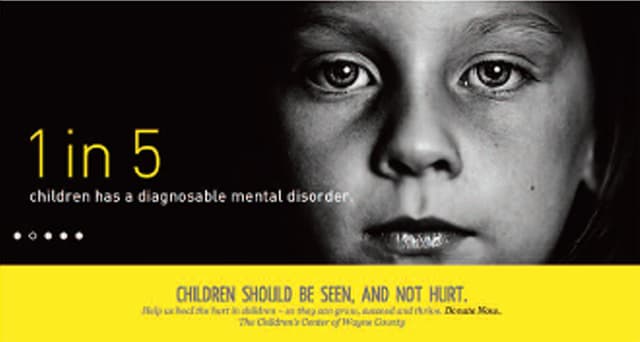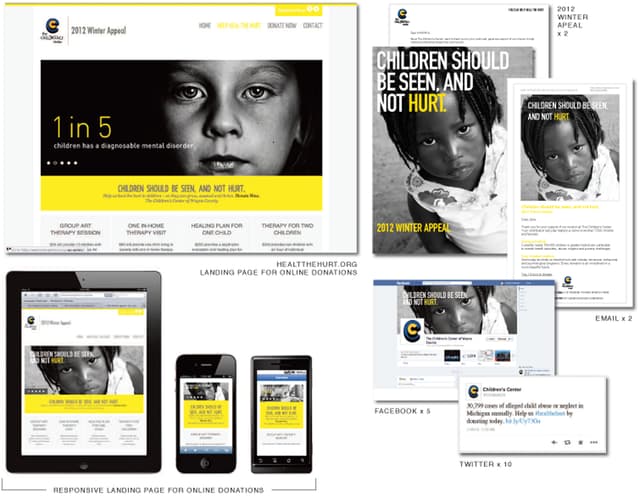The Children’s Center, Detroit: ‘children should be seen and not hurt’ winter appeal
- Exhibited by
- R Trent Thompson and Tammy Zonker
- Added
- November 05, 2014
- Medium of Communication
- Multi-channel annual fund (direct mail, online, custom landing-page appeal).
- Target Audience
- Individuals.
- Type of Charity
- Children and young people
- Country of Origin
- United States
- Date of first appearance
- November 2012
SOFII’s view
By combining images and words powerfully to get their mission – to heal the hurt in children – across to donors The Children's Center in Detroit managed to turn a dire financial situation into an inspiring success. They achieved this by blending together a range of different communications channels and making sure that they all worked together.
Summary / objectives
Over the past few years, The
Children’s Center (TCC) has experienced less than desirable results from its
annual appeal campaign. This appeal’s net revenue in 2010 yielded $0.97 and in
2011 there was a loss of $2,000.00. First-time donors decreased by 61 per cent
from 2011 to 2014. Online donations accounted for only two per cent of total
revenue and the donor email list represented only 27 per cent of the entire
donor database. Social media activity was non-existent and no volunteer to
donor conversion strategy existed.
Background
The 2012 annual (winter) appeal: ‘children should be seen and not hurt’, was based on a seamless, tightly integrated, multichannel strategy encompassing the entire multi-staged communications cycle – from the very first donor touch to the final acknowledgement letter.
Campaign messaging
First, we developed a campaign strategy incorporating powerful imagery and compelling editorial to convey clearly the heart of our mission – to heal the hurt in children.
Direct mail
Next, we developed a two-staged
direct mail approach targeting volunteers and lapsed donors. The first mailing,
targeted at three segments of donors, included a personalised pledge sheet that
varied depending upon the donor’s previous giving level. Each personalised
pledge sheet offered three dollar-value options, including an impact statement
that illustrated what the gift value could accomplish. In addition, an ‘other
amount’ fill-in-the-blank line was provided.
The second mailing, titled It’s Not Too Late, was sent three weeks later, but only to those who had not yet responded to the first mailing or email. This second mailing used different imagery, was more succinct, conveyed a sense of urgency and included another segmented, personalised pledge sheet.
Email
Three staged emails were sent three weeks apart to reinforce campaign
messaging and the call to action. All emails provided a link back to the custom
landing page.
Because the donor email list was comprised of only 27 per cent of our entire donor database, we wanted also to expand it for future communications. So, we requested all recipients of campaign communications to provide their email address via the pledge form, email, or sign-up form on the custom landing page.
To engage
and accommodate all mobile traffic, we created a custom, responsive landing page
that incorporated the theme of the annual appeal, reinforced campaign messaging
and converted online donations.
Social media
Facebook/Twitter: we formed an internal ‘social media centre of excellence’.
The social media team is comprised of 27 staff members. We also recruited an
untold number of external key influencers to help spread the word about the
annual appeal.
To make it easy for all to help, we drafted pre-written Facebook posts and tweets, accompanied by selected campaign images for each to share with their respective social networks. We also empowered our Facebook fans to help spread the word about the campaign by creating multiple Facebook cover photos to be uploaded to their personal Facebook pages. Each cover photo included a powerful image, campaign tagline and web address to the custom, responsive landing page.
Linkedin/Pinterest: to further elevate awareness of our annual appeal, we executed an online campaign via Linkedin, targeted to potential donors who met a specific demographic and live in and around the city of Detroit.
The ad campaign did not ask directly for donations. Its purpose was to raise awareness of the mental, physical and behavioural challenges faced by over 100,000 children in Detroit. However, each ad did drive traffic to the campaign landing page, which presented additional information regarding the plight of Detroit’s children.
We also created a Pinterest profile to further extend our reach, elevate campaign awareness and drive traffic back to the campaign site.
To ensure we successfully closed the loop with each of our donors, we re-wrote our system of acknowledgement letters to enable the inclusion of personalised and campaign-relevant messaging as well as facilitate ongoing cultivation and stewardship.
We continued using the traditional face-to-face and telephone channels when appropriate.
Special characteristics
The campaign was recognised by the Integrated Marketing Advisory Board http://www.imabgroup.net/posts/2013/july/compelling-message-through-multiple-channels.html
Costs
Campaign cost per dollar raised .09 cents.
Results
Raised more than $70,000 in net contributions.


















